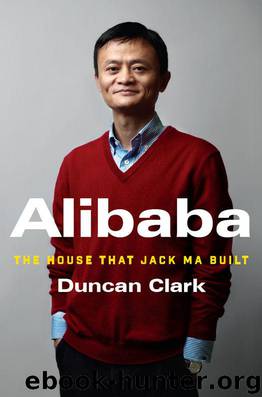0062413406 (N) by Duncan Clark

Author:Duncan Clark
Language: eng
Format: azw3, epub
Publisher: HarperCollins
Published: 2016-04-11T16:00:00+00:00
eBay Comes to China
In the fall of 2001, eBay CEO Meg Whitman made a trip to Shanghai to meet Bo. In March 2002, EachNet once again surprised the market with a landmark deal, announcing it was selling a 33 percent stake to eBay for $30 million.
Despite EachNet’s challenges, eBay had been impressed by what it saw. The EachNet website had more than three million registered users, of which over 100,000 visited the site each day. The company had expanded from Shanghai to Beijing and Guangzhou. More than half of its business involved a party outside one of these cities. The site featured more than 50,000 items at any time, ranging from clothing to real estate, and offered by fixed prices or via auctions. Transactions exceeded $2 million a month.
EachNet was tiny compared to eBay. But the allure of China was of critical importance to Whitman. She badly needed some good news to reassure investors after announcing just one month earlier the loss of the Japanese market to Yahoo Japan, backed by Masayoshi Son’s SoftBank, a blow to Whitman’s ambition to build eBay as a “truly global marketplace.” From $750 million in 2001, eBay was targeting $3 billion global revenue by 2005. Japan would have been a big step in achieving this, with more than $1.6 billion in goods traded, but eBay was late11 to the party there, launching only in February 2000, five months after Yahoo Japan. eBay’s strategy was a mess from the start. In Japan, eBay charged commissions but its competitor Yahoo Japan did not. Credit cards were still a rarity in Japan but eBay required customers to use them to register on its site. eBay chose a Japanese CEO and a local partner (NEC) with little experience of the Internet, charting a rapid course for irrelevance in the country. By the summer of 2001 it had garnered a measly 3 percent of the market. When in February 2002 eBay pulled the plug, its site offered just 25,000 products, compared to the 3.5 million on offer from its rival Yahoo Japan. In the Land of the Rising Sun, the sun had already set on eBay’s ambitions and the company laid off its staff.
Where next? eBay had more success in South Korea12 and Taiwan,13 but only China could really move the needle. By 2002, China’s Internet population had grown to over 27 million, the world’s fifth largest.14 Whitman was earlier than many in Silicon Valley to recognize the importance of China: “With the demographics and incredible changes in China, our hypothesis is this could be one of the largest e-commerce markets in the world,” she told the media, projecting $16 billion in e-commerce revenue by 2006.
eBay had failed to understand the needs of local customers in Japan but Whitman was determined not to repeat the experience in China. They wanted to back a leading player in the local market. EachNet was an obvious target. eBay senior vice president Bill Cobb later commented, “[Bo] had studied eBay up one side and down the other and had really tried to adapt a lot of the eBay principles to the market.
Download
This site does not store any files on its server. We only index and link to content provided by other sites. Please contact the content providers to delete copyright contents if any and email us, we'll remove relevant links or contents immediately.
Spell It Out by David Crystal(35347)
Underground: A Human History of the Worlds Beneath Our Feet by Will Hunt(11256)
A Year in the Merde by Stephen Clarke(4652)
Venice by Jan Morris(2051)
Claridge's: The Cookbook by Nail Martyn & Erickson Meredith(1962)
My Paris Kitchen: Recipes and Stories by Lebovitz David(1893)
A TIME OF GIFTS by Patrick Leigh Fermor(1847)
The Plantagenets by Dan Jones(1615)
Welcome to the Goddamn Ice Cube by Blair Braverman(1601)
Bang Poland: How To Make Love With Polish Girls In Poland by Roosh V(1587)
Top 10 Prague (EYEWITNESS TOP 10 TRAVEL GUIDES) by DK(1567)
From Russia with Lunch by David Smiedt(1551)
The Finnish Way by Katja Pantzar(1535)
The Isle of Mull by Terry Marsh(1517)
A TIME TO KEEP SILENCE by Patrick Leigh Fermor(1499)
A Taste of Paris by David Downie(1491)
Rick Steves London 2018 by Rick Steves & Gene Openshaw(1490)
Merde in Europe by Stephen Clarke(1435)
Insight Guides Experience Tokyo by Insight Guides(1416)
